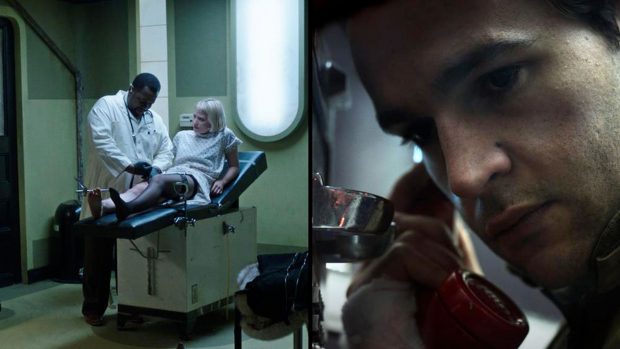STEMMED FROM IDEA IN NOVEL OF HIDDEN PERSPECTIVES, & ALSO STYLISTICALLY CITES DE PALMA
 Nicolas Pesce's Piercing opened yesterday in theaters and streaming on demand. It is Pesce's second feature, following his singularly strange and vivid feature debut from 2016, The Eyes Of My Mother. Piercing, which had its world premiere last year at Sundance, is an adaptation of a novel by Ryū Murakami, and stars Mia Wasikowska and Christopher Abbott. In a review at Rue Morgue, Shawn Macomber writes that the film "has the vibe of Brian De Palma co-directing with Michael Haneke and David Lynch. Piercing is menacing, darkly funny, subversive, grotesque, sexy, challenging, stimulating, immersive and monumentally fucking weird."
Nicolas Pesce's Piercing opened yesterday in theaters and streaming on demand. It is Pesce's second feature, following his singularly strange and vivid feature debut from 2016, The Eyes Of My Mother. Piercing, which had its world premiere last year at Sundance, is an adaptation of a novel by Ryū Murakami, and stars Mia Wasikowska and Christopher Abbott. In a review at Rue Morgue, Shawn Macomber writes that the film "has the vibe of Brian De Palma co-directing with Michael Haneke and David Lynch. Piercing is menacing, darkly funny, subversive, grotesque, sexy, challenging, stimulating, immersive and monumentally fucking weird."In a discussion with The Film Stage's Mike Mazzanti, Pesce mentions De Palma as he talks about the development of the split screens used in Piercing:
There are visual components in both The Eyes of My Mother and Piercing that speak to a kind of slow cinema interest; they’re very observational at times. When you’re prepping a film, do you look to bring specific aesthetic sensibilities to each script you write, or does it first depend on the story and the material and what they require?It starts off as whatever pops into my head. I sort of have a mental library of movie moments that are perpetually collaged, whether that’s to contextualize movies, or my own life, or my own movies. So, I think that it starts with whatever naturally comes to me—as I’m writing it, reading it, whatever—and then once I know what it looks like in my head I start realizing more where those references are coming from. Sometimes I’m not aware of it, but by the time we were making Piercing, I knew we were making a giallo movie.
Going off of that, this feeling of the commonplace is counteracted by the viscera and the sense of psychopathy in the air from Reed.
Yep.
Which is punctuated by the sharp cutting. While violence and observation are far from being mutually exclusive, they create an interesting dichotomy in Piercing, and sometimes an emotional detachment or distance. How do you go about balancing these visual and conceptual ideas during prep and also in the edit?
It’s really on a case-by-case basis. I think something that’s always been fun for me about filmmaking is that there’s always been a level of experimentation to it. There’s always discoveries that come during every stage. There’s this idea that starts in the book; you’re in their perspectives but you don’t actually know what’s going on.
So, for each character, the things that are going on in their heads are drastically different. So, I thought, how could we communicate these two worlds, but together in the same place, but so disconnected? So, very quickly I was thinking split-screen. Part of it is stylistic—I love Brian De Palma, and he dealt very much in the wheelhouse of what we were doing—but it also conceptually tied in really nicely, this kind of idea of contrasting views of the same thing.
So, we had always known that split-screens were going to be an element of the movie. But initially, it was only planned for the one sequence with Reed on the phone with his wife. And, as we were editing, we were like, this does work the way we wanted it to—where can we find other places to do it? And so, the two other places are key character moments; the first is where Jackie and Reed meet for the first time, and we’re showing how different their lead-ups are to the same moment.
Then, at another moment, Jackie and Reed finally think they’re on the same page—they’re flirting on the couch, they both think they know what’s going on, and they’re both with it—and there’s a moment where something is off, and they both don’t know what’s wrong but they realize they’re on the same page, and we jump back to split screen again. So, you have to find techniques that play into the stylistic choices that you’re trying to make, but it also has to be an element that’s helping the narrative or at least the emotion along, as well.
Updated: Sunday, February 3, 2019 12:35 AM CST
Post Comment | View Comments (1) | Permalink | Share This Post



